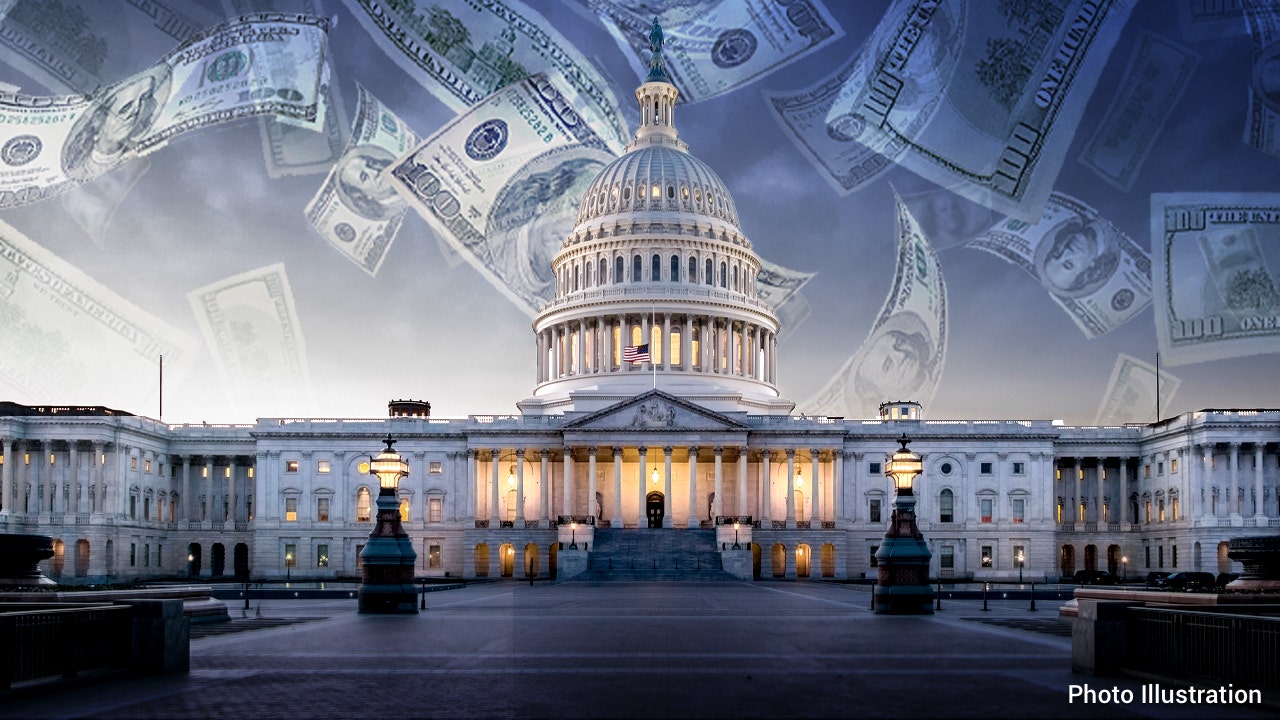Economist Peter Morici breaks down what the national debt is, why it ballooned to more than $34 trillion and what it means for Americans.
The U.S. national debt is climbing at a rapid pace and has shown no signs of slowing down, despite the growing criticism of massive levels of government spending.
The national debt — which measures what the U.S. owes its creditors — rose to $35,945,396,362,475.20 as of November 12th, according to the latest numbers published by the Treasury Department. That is up about $1.8 billion from the figure reported the previous day.
By comparison, just four decades ago, the national debt hovered around $907 billion.
The outlook for the federal debt level is bleak, with economists increasingly sounding the alarm over the torrid pace of spending by Congress and the White House. Interest payments on the debt for the government’s fiscal year, which begins in October, now exceed the costs of Medicare and the defense budget.
SOARING DEFICITS TO PUSH PUBLICLY HELD DEBT TO RECORD LEVEL IN 4 YEARS
The latest findings from the Congressional Budget Office indicate that the national debt will grow to an astonishing $54 trillion in the next decade, the result of an aging population and fishing federal health care costs. Higher interest rates are also compounding the pain of higher debt.
Should that debt materialize, it could risk America’s economic standing in the world.
“America’s fiscal outlook is more dangerous and daunting than ever, threatening our economy and the next generation,” said Michael Peterson, the CEO of the Peter G. Peterson Foundation that advocates for reducing the federal deficit. “This is not the future any of us want, and it’s no way to run a great nation like ours.”
LARGE DEFICITS, HIGH INTEREST RATES MAKING FEDERAL DEBT LESS SUSTAINABLE
The unrelenting increase is what prompted Fitch Ratings to issue a surprise downgrade of the nation’s long-term credit score in mid-2023. The agency cut the U.S. debt by one notch, snatching away its pristine AAA rating in exchange for an AA+ grade. In making the decision, Fitch cited alarm over the country’s deteriorating finances and expressed concerns over the government’s ability to address the ballooning debt burden amid sharp political divisions.
“This is a warning shot across the U.S. government’s bow that it needs to right its fiscal ship,” Sean Snaith, an economist at the University of Central Florida, told FOX Business. “You can’t just spend trillions of dollars more than you have in revenue every year and expect no ill consequences.”
The spike in the national debt follows a burst of spending by President Biden and Democratic lawmakers.
As of September 2022, Biden had already approved roughly $4.8 trillion in borrowing, including $1.85 trillion for a COVID relief measure dubbed the American Rescue Plan and $370 billion for the bipartisan infrastructure bill, according to the Committee for a Responsible Federal Budget (CRFB), a group that advocates for reducing the deficit.
THE US IS PAYING A RECORD AMOUNT OF INTEREST ON ITS NATIONAL DEBT
While that is about half of the $7.5 trillion that former President Donald Trump added to the deficit while he was in office, it’s far more than the $2.5 trillion Trump had approved at that same point during his term.
Biden has repeatedly defended the spending by his administration and boasted about cutting the deficit by $1.7 trillion.
“I might note parenthetically: In my first two years, I reduced the debt by $1.7 trillion. No President has ever done that,” Biden said recently.
However, that figure refers to a reduction in the national deficit between fiscal years 2020 and 2022; while the deficit did shrink during that time period, that is largely because emergency measures put into place during the COVID-19 pandemic expired.
The White House has also tried to blame Republicans for the astronomical rise in debt in recent years.
“This is the trickle-down debt — driven overwhelmingly by repeated Republican giveaways skewed to big corporations and the wealthy,” Michael Kikukawa, White House assistant press secretary, said in a statement provided to FOX Business after the debt surpassed $34 trillion.
US NATIONAL DEBT TOPS $34T FOR FIRST TIME IN HISTORY
Even more worrisome is that the spike in interest rates over the past year and a half has made the cost of servicing the national debt more expensive.
That is because as interest rates rise, the federal government’s borrowing costs on its debt will also increase. In fact, interest payments on the national debt are projected to be the fastest-growing part of the federal budget over the next three decades, according to the CRFB.
The U.S. Capitol in Washington, D.C. (Julia Nikhinson/Bloomberg via Getty Images / Getty Images)
CLICK HERE TO READ MORE ON FOX BUSINESS
Payments are expected to triple from nearly $475 billion in fiscal year 2022 to a stunning $1.4 trillion in 2032. By 2053, the interest payments are projected to surge to $5.4 trillion. To put that into perspective, that will be more than the U.S. spends on Social Security, Medicare, Medicaid and all other mandatory and discretionary spending programs.
“We are clearly on an unsustainable fiscal path,” CRFB President Maya MacGuineas said. “We need to do better.”
While the debt has been a source of concern among politicians and budget hawks, just how worried should you be about the nation’s rapid pace of borrowing?
Experts say that the higher the debt climbs, the more the U.S. is paying in interest costs each year. Those expenses can eclipse important public investments that fuel economic growth — areas like education, research and development and infrastructure.
“A nation saddled with debt will have less to invest in its own future,” the Peter G. Peterson Foundation said.
A Pew Research Center survey published in 2023 found that 57% of Americans think reducing the budget deficit should be a top priority for the president and Congress — up from just 45% the previous year.

